KSHV Latency Locus Cooperates with Myc to Drive Lymphoma in Mice
- PMID: 26327622
- PMCID: PMC4556645
- DOI: 10.1371/journal.ppat.1005135
KSHV Latency Locus Cooperates with Myc to Drive Lymphoma in Mice
Abstract
Kaposi sarcoma-associated herpesvirus (KSHV) has been linked to Kaposi sarcoma and B-cell malignancies. Mechanisms of KSHV-induced oncogenesis remain elusive, however, in part due to lack of reliable in vivo models. Recently, we showed that transgenic mice expressing the KSHV latent genes, including all viral microRNAs, developed splenic B cell hyperplasia with 100% penetrance, but only a fraction converted to B cell lymphomas, suggesting that cooperative oncogenic events were missing. Myc was chosen as a possible candidate, because Myc is deregulated in many B cell lymphomas. We crossed KSHV latency locus transgenic (latency) mice to Cα Myc transgenic (Myc) mice. By itself these Myc transgenic mice develop lymphomas only rarely. In the double transgenic mice (Myc/latency) we observed plasmacytosis, severe extramedullary hematopoiesis in spleen and liver, and increased proliferation of splenocytes. Myc/latency mice developed frank lymphoma at a higher rate than single transgenic latency or Myc mice. These data indicate that the KSHV latency locus cooperates with the deregulated Myc pathways to further lymphoma progression.
Conflict of interest statement
The authors have declared that no competing interests exist.
Figures
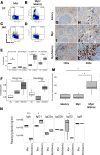
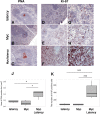
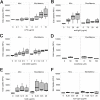
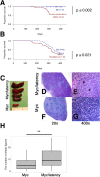
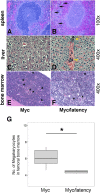
Similar articles
-
Myc is required for the maintenance of Kaposi's sarcoma-associated herpesvirus latency.J Virol. 2010 Sep;84(17):8945-8. doi: 10.1128/JVI.00244-10. Epub 2010 Jun 23. J Virol. 2010. PMID: 20573831 Free PMC article.
-
Kaposi sarcoma-associated herpesvirus-encoded viral FLICE inhibitory protein (vFLIP) K13 cooperates with Myc to promote lymphoma in mice.Cancer Biol Ther. 2010 Nov 15;10(10):1033-40. doi: 10.4161/cbt.10.10.13291. Epub 2010 Nov 15. Cancer Biol Ther. 2010. PMID: 20818173 Free PMC article.
-
The latency-associated nuclear antigen of Kaposi sarcoma-associated herpesvirus induces B cell hyperplasia and lymphoma.J Clin Invest. 2006 Mar;116(3):735-42. doi: 10.1172/JCI26190. Epub 2006 Feb 23. J Clin Invest. 2006. PMID: 16498502 Free PMC article.
-
Biology and oncogenicity of the Kaposi sarcoma herpesvirus K1 protein.Rev Med Virol. 2015 Sep;25(5):273-85. doi: 10.1002/rmv.1843. Epub 2015 Jul 20. Rev Med Virol. 2015. PMID: 26192396 Review.
-
Kaposi's sarcoma-associated herpesvirus (KSHV/HHV8): key aspects of epidemiology and pathogenesis.AIDS Rev. 2003 Oct-Dec;5(4):222-9. AIDS Rev. 2003. PMID: 15012001 Review.
Cited by
-
Animal models of tumorigenic herpesviruses--an update.Curr Opin Virol. 2015 Oct;14:145-50. doi: 10.1016/j.coviro.2015.09.006. Curr Opin Virol. 2015. PMID: 26476352 Free PMC article. Review.
-
Regulation of the Macroautophagic Machinery, Cellular Differentiation, and Immune Responses by Human Oncogenic γ-Herpesviruses.Viruses. 2021 May 8;13(5):859. doi: 10.3390/v13050859. Viruses. 2021. PMID: 34066671 Free PMC article. Review.
-
Tumor Microenvironment Conditioning by Abortive Lytic Replication of Oncogenic γ-Herpesviruses.Adv Exp Med Biol. 2020;1225:127-135. doi: 10.1007/978-3-030-35727-6_9. Adv Exp Med Biol. 2020. PMID: 32030652 Review.
-
The Role of Lytic Infection for Lymphomagenesis of Human γ-Herpesviruses.Front Cell Infect Microbiol. 2021 Mar 26;11:605258. doi: 10.3389/fcimb.2021.605258. eCollection 2021. Front Cell Infect Microbiol. 2021. PMID: 33842383 Free PMC article. Review.
-
Gammaherpesvirus-infected germinal center cells express a distinct immunoglobulin repertoire.Life Sci Alliance. 2020 Feb 6;3(3):e201900526. doi: 10.26508/lsa.201900526. Print 2020 Mar. Life Sci Alliance. 2020. PMID: 32029571 Free PMC article.
References
-
- Jaffe ES, Pittaluga S (2011) Aggressive B-cell lymphomas: a review of new and old entities in the WHO classification. Hematology / the Education Program of the American Society of Hematology American Society of Hematology Education Program 2011: 506–514. 10.1182/asheducation-2011.1.506 - DOI - PMC - PubMed
-
- Adams JM, Harris AW, Pinkert CA, Corcoran LM, Alexander WS, et al. (1985) The c-myc oncogene driven by immunoglobulin enhancers induces lymphoid malignancy in transgenic mice. Nature 318: 533–538. - PubMed
Publication types
MeSH terms
Substances
Grants and funding
LinkOut - more resources
Full Text Sources
Other Literature Sources
Molecular Biology Databases
Research Materials
Miscellaneous

